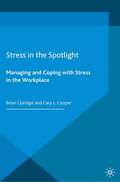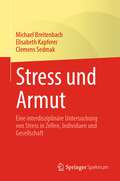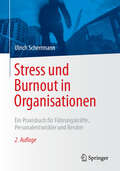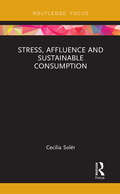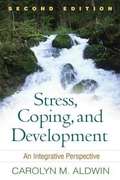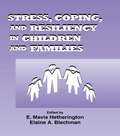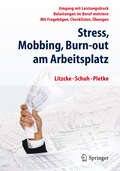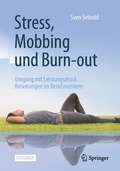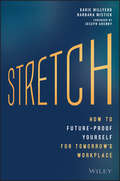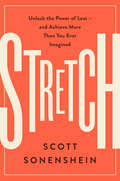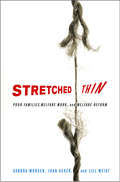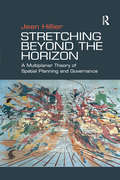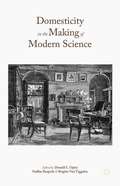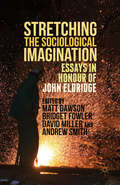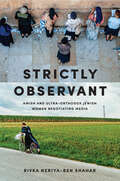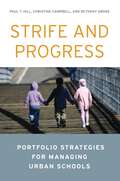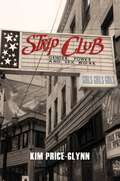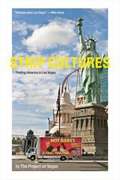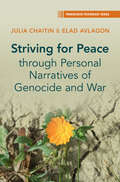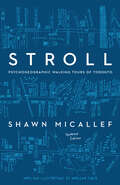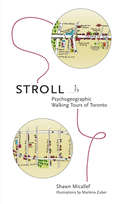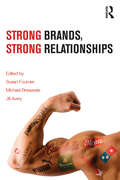- Table View
- List View
Stress in the Spotlight: Managing and Coping with Stress in the Workplace
by B. Claridge C. CooperBased upon interviews with individuals in high pressure positions, from business leaders to a bomb disposal expert, this book provides practical insight about how to identify, tackle and overcome any kind of stress.
Stress und Armut: Eine interdisziplinäre Untersuchung von Stress in Zellen, Individuen und Gesellschaft
by Clemens Sedmak Michael Breitenbach Elisabeth KapfererDas Wort Stress ist allgegenwärtig und ist ein Modewort geworden. Jeder ist gestresst, so scheint es, und das fortwährend. Dieses Buch befasst sich mit der Bedeutung von Stress in den Natur- und Geisteswissenschaften und untersucht zellulären Stress als Ursache für Stress und im Zusammenhang mit dem, was Menschen als Stress erleben. Wann empfinden wir in psychologischem Sinn Stress und wann zeigen wir physiologische Anzeichen von Stress in unserem Gehirn?Stress ist eine Abweichung von dem, was sich „normal“ und gesund anfühlt. Er kann durch soziale oder ökonomische Faktoren ausgelöst werden und kann chronisch werden, was erhebliche Auswirkungen auf den einzelnen Menschen und auf die Gesellschaft als Ganzes hat. Dieses Buch konzentriert sich auf Armut als eine chronische Ursache von Stress und untersucht, wie der Mangel an druckfreier Zeit, die Entbehrungen und die Unvorhersehbarkeit des Alltags sowie ein allgemeiner Mangel an Schutz zu destruktivem toxischem Stress führen. Dieser permanente Druck beeinträchtigt die kognitiven und sozialen Funktionen, die Gehirnentwicklung in der Kindheit und kann auch zu vorzeitiger Alterung führen. Was können die Wissenschaften für unser Verständnis von und unsere Reaktion auf Stress leisten? Was kann gegen toxischen Stress getan werden, sowohl auf persönlicher Ebene als auch in Bezug auf Strukturen und politische Maßnahmen?Das Buch richtet sich an alle, die sich für Stress, seine Ursachen und Folgen sowie für den Zusammenhang von Stress und Armut interessieren.
Stress und Burnout in Organisationen: Ein Praxisbuch für Führungskräfte, Personalentwickler und Berater
by Ulrich ScherrmannDieses Buch hilft Führungskräften, Organisationsberatern und Coaches, Stress und Burnout im Unternehmen zu erkennen und zu bekämpfen. Es setzt dabei nicht nur bei individuellen Faktoren an, sondern auch bei dem, was wirklich hilft: Es erklärt organisationale Faktoren von Burnout in einem verständlichen, systemischen Organisationsmodell. Neben Grundwissen zu Ursachen von Burnout werden Tipps für einen adäquaten Umgang gegeben, die u.a. ein neues Paradigma von Gesundheit in Betrieben und Organisationen und das Thema Prävention umfassen. Der Praxisteil des Buches vermittelt konkrete Methoden und Checklisten für Führungskräfte sowie für die ganze Organisation. Erfahrungsberichte aus der Beratungsarbeit runden dieses praxisorientierte Handbuch ab.
Stress und Emotionen in der aktiven Mobilität messen: Potenziale und Grenzen der Humansensorik für die Verkehrsplanung (Studien zur Mobilitäts- und Verkehrsforschung)
by Linda DörrzapfFußgänger*innen und Radfahrer*innen sind unmittelbar den Einflüssen der gebauten Umwelt ausgesetzt, die auf das Wohlbefinden wirken und Stress auslösen können. Solche Stressmomente können als physiologische Signale (z.B. Hautleitfähigkeit) sensorbasiert gemessen werden. Diese Messung, auch Humansensorik genannt, kann Aufschlüsse über ein (negatives) Erlebnis beim Zufußgehen oder Radfahren geben und somit subjektive Erfahrungen quantifizierbar machen, ist aber noch weit entfernt vom Einsatz im praktischen (verkehrs-)planerischen Feld. In dieser Arbeit werden relevante Theorien und Begriffe der Emotionspsychologie sowie der Stadt- und Verkehrsplanung in Bezug auf Stress und Emotionen und deren Genese beschrieben. Die methodische Vorgehensweise und Nutzer*innen-Akzeptanz der Humansensorik wird außerdem anhand von Fallbeispielen verglichen und analysiert. Als Kern der Arbeit werden die Potenziale der Humansensorik für die Planung und Gestaltung von öffentlichen Räumen mit Expert*innen reflektiert. Dabei wird ein Fokus auf die Anwendbarkeit, Grenzen und Potenziale der Humansensorik in (Verkehrs-)Planungsprozessen gelegt. Abschließend werden Anforderungen und Mehrwert der Humansensorik für die Planungspraxis erläutert und diskutiert.
Stress, Affluence and Sustainable Consumption (Routledge Studies in Sustainability)
by Cecilia SolérWhy do affluent consumers almost automatically acquire new versions or variations of products already at their disposal? Even though most of us know that this novelty consumption poses a serious threat to an environmentally and socially sustainable future, we continue to do it. Why? Research shows that consumption of new automobiles, clothing, furniture, electronics, home furnishing, household apparel, mobile phones, etc., is motivated by a desire to feel more secure, less anxious and better mood-wise. Affluent consumers seem to engage in novelty consumption not to feel better but rather to avoid feeling bad. Stress, Affluence and Sustainable Consumption discusses sustainable consumption from a stress perspective, adding an embodied understanding to the sustainability-related consumption challenges that we face today. A stress perspective on affluent consumption differs from current understandings on consumption, as it fully acknowledges the consumer as having a body (including a mind) that reacts to the numerous product offerings and retail spaces, both physical and online. A stress perspective can explain how our bodies try to cope with an overload of perceptual input provided by advertising messages, product launches and even store structures. This book will be of great interest to students and researchers of consumer psychology, sustainable consumption studies, sustainable marketing and markets as well as sustainable development more generally.
Stress, Coping, and Development, Second Edition
by Carolyn AldwinHow do people cope with stressful experiences? What makes a coping strategy effective for a particular individual? This volume comprehensively examines the nature of psychosocial stress and the implications of different coping strategies for adaptation and health across the lifespan. Carolyn M. Aldwin synthesizes a vast body of knowledge within a conceptual framework that emphasizes the transactions between mind and body and between persons and environments. She analyzes different kinds of stressors and their psychological and physiological effects, both negative and positive. Ways in which coping is influenced by personality, relationships, situational factors, and culture are explored. The book also provides a methodological primer for stress and coping research, critically reviewing available measures and data analysis techniques. New to This Edition Incorporates advances in concepts, tools, and data. Chapters addressing physiology and physical health. Expanded coverage of sociocultural and religious aspects of coping, and of childhood, young adulthood, and mid-life. New perspectives on emotion regulation and stress-related growth.
Stress, Coping, and Resiliency in Children and Families (Advances in Family Research Series)
by E. Mavis Hetherington Elaine A. BlechmanConcern with stress and coping has a long history in biomedical, psychological and sociological research. The inadequacy of simplistic models linking stressful life events and adverse physical and psychological outcomes was pointed out in the early 1980s in a series of seminal papers and books. The issues and theoretical models discussed in this work shaped much of the subsequent research on this topic and are reflected in the papers in this volume. The shift has been away from identifying associations between risks and outcomes to a focus on factors and processes that contribute to diversity in response to risks. Based on the Family Research Consortium's fifth summer institute, this volume focuses on stress and adaptability in families and family members. The papers explore not only how a variety of stresses influence family functioning but also how family process moderates and mediates the contribution of individual and environmental risk and protective factors to personal adjustment. They reveal the complexity of current theoretical models, research strategies and analytic approaches to the study of risk, resiliency and vulnerability along with the central role risk, family process and adaptability play in both normal development and childhood psychopathology.
Stress, Mobbing und Burn-out am Arbeitsplatz
by Sven Litzcke Horst Schuh Matthias PletkeStress gilt als eine der größten Gesundheitsgefahren - häufig ist die Ursache der Dauerstress, den Leistungs- und Zeitdruck am Arbeitsplatz erzeugen. Dabei kann Stress positiv wirken, wenn die Bedingungen stimmen. Die Autoren zeigen, wie sich ein Weg zwischen negativem Stress und positiven Herausforderungen finden lässt. Dazu liefern sie Grundlagenwissen zur Entstehung und zu den Folgen von Stress sowie praxisorientierte Methoden zur Stressbewältigung. Neu in der 6. Auflage: Material zu Mobbing und Burn-out sowie Hinweise zu rechtlichen Problemen.
Stress, Mobbing und Burn-out: Umgang mit Leistungsdruck — Belastungen im Beruf meistern
by Sven SeiboldStress gilt als eine der größten Gesundheitsgefahren – häufig ist die Ursache der Dauerstress, den Leistungs- und Zeitdruck am Arbeitsplatz erzeugen. Dabei kann Stress positiv wirken, wenn die Bedingungen stimmen. Die Autoren zeigen, wie sich ein Weg zwischen negativem Stress und positiven Herausforderungen finden lässt. Dazu liefern sie Grundlagenwissen zur Entstehung und zu den Folgen von Stress sowie praxisorientierte Methoden zur Stressbewältigung. Neu in der 6. Auflage: Material zu Mobbing und Burn-out sowie Hinweise zu rechtlichen Problemen.
Stressmanagement: Ein Arbeitsbuch für die Aus-, Fort- und Weiterbildung
by Stephan RuschDieses Theorie- und Praxismanual gibt einen grundlegenden und wissenschaftlich fundierten Überblick über alle Themen des Stressmanagements: Von theoretischen Grundlagen zu Stress und Stressreaktionen über Methoden zur Analyse und Stressbewältigung bis hin zu praktischen Anregungen für die Durchführung eigener Stressmanagementseminare.Mit zahlreichen Arbeitsmaterialien und Fragen zur Überprüfung des eigenen Wissensstandes.
Stretch: How to Future-Proof Yourself for Tomorrow's Workplace
by Joseph Grenny Karie Willyerd Barbara MistickYou know you can do more with your career. And the future is going to demand more of you. The problem is you are so busy keeping up with the day-to-day that you can't prepare for tomorrow. Stretch: How to Future Proof Yourself for Tomorrow's Workplace gives you the confidence and knowledge you need to achieve your goals in an ever-changing world. Karie Willyerd and Barbara Mistick--established experts and the collective winners of dozens of awards in the field of personal development and learning--offer evidence-based guidance on obtaining the skills you will need to thrive in tomorrow's workplace. Built on solid, global research and dozens of personal interviews with people who have achieved new and inspiring goals, Stretch offers advice, valuable insights, anecdotes, and recommendations to make achieving your goals practical and within reach. If you are like other professionals, your biggest worry is becoming obsolete at work. Shifting technologies, fierce competition among corporations, and recruitment occurring on a global level would give anyone concern. To remain relevant in spite of change, you need to know how to: Learn in any situation Open your thinking to a world beyond where you are now Connect to the people who can help you make your future happen Seek experiences that will prepare you for tomorrow Stay motivated through the ups and downs of a career so you can bounce forward Stretch: How to Future Proof Yourself for Tomorrow's Workplace offers five practices to help you start, enhance, and lengthen your career by anticipating the needs of tomorrow's work environment. Don't become obsolete. Instead, stretch to achieve your potential.
Stretch: Unlock the Power of Less -and Achieve More Than You Ever Imagined
by Scott SonensheinA groundbreaking approach to succeeding in business and life, using the science of resourcefulness.We often think the key to success and satisfaction is to get more: more money, time, and possessions; bigger budgets, job titles, and teams; and additional resources for our professional and personal goals. It turns out we’re wrong. Using captivating stories to illustrate research in psychology and management, Rice University professor Scott Sonenshein examines why some people and organizations succeed with so little, while others fail with so much.People and organizations approach resources in two different ways: “chasing” and “stretching.” When chasing, we exhaust ourselves in the pursuit of more. When stretching, we embrace the resources we already have. This frees us to find creative and productive ways to solve problems, innovate, and engage our work and lives more fully.Stretch shows why everyone—from executives to entrepreneurs, professionals to parents, athletes to artists—performs better with constraints; why seeking too many resources undermines our work and well-being; and why even those with a lot benefit from making the most out of a little.Drawing from examples in business, education, sports, medicine, and history, Scott Sonenshein advocates a powerful framework of resourcefulness that allows anybody to work and live better.
Stretched Thin: Poor Families, Welfare Work, and Welfare Reform
by Sandra Morgen Jill Weigt Joan AckerWhen the Personal Responsibility and Work Opportunity Reconciliation Act became law in 1996, the architects of welfare reform celebrated what they called the new "consensus" on welfare: that cash assistance should be temporary and contingent on recipients' seeking and finding employment. However, assessments about the assumptions and consequences of this radical change to the nation's social safety net were actually far more varied and disputed than the label "consensus" suggests. By examining the varied realities and accountings of welfare restructuring, Stretched Thin looks back at a critical moment of policy change and suggests how welfare policy in the United States can be changed to better address the needs of poor families and the nation. Using ethnographic observations, in-depth interviews with poor families and welfare workers, survey data tracking more than 750 families over two years, and documentary evidence, Sandra Morgen, Joan Acker, and Jill Weigt question the validity of claims that welfare reform has been a success. They show how poor families, welfare workers, and welfare administrators experienced and assessed welfare reform differently based on gender, race, class, and their varying positions of power and control within the welfare state. The authors document the ways that, despite the dramatic drop in welfare rolls, low-wage jobs and inadequate social supports left many families struggling in poverty. Revealing how the neoliberal principles of a drastically downsized welfare state and individual responsibility for economic survival were implemented through policies and practices of welfare provision and nonprovision, the authors conclude with new recommendations for reforming welfare policy to reduce poverty, promote economic security, and foster shared prosperity.
Stretching Beyond the Horizon: A Multiplanar Theory of Spatial Planning and Governance
by Jean HillierIn this innovative work Jean Hillier develops a new theory for students and researchers of spatial planning and governance which is grounded primarily in the work of Gilles Deleuze. The theory recognizes the complex interrelation between place qualities and the multiple space-time relational dynamics of spatial governance. Using empirical examples from England and Australia, Hillier identifies the power of networks and trajectories through which various actors territorialize space and explores the social and political responsibilities of spatial managers and decision-makers. She considers what spatial planning and urban management practices could look like if they were to be developed along Deleuzean lines, and suggests alternative framings for spatial practice: broad trajectories or 'visions' of the longer-term future and shorter-term, location-specific detailed plans and projects with collaboratively determined tangible goals.
Stretching the Sociological Imagination: Essays in Honour of John Eldridge
by David Miller Andrew Smith Matt Dawson Bridget FowlerThis edited collection calls for renewed attention to the concept of the sociological imagination, allowing social scientists to link private issues to public troubles. Inspired by the eminent Glasgow-based sociologist, John Eldridge, it re-engages with the concept and shows how it can be applied to analyzing society today.
Stretching the Sociological Imagination: Essays in Honour of John Eldridge
by David Miller Andrew Smith Matt Dawson Bridget FowlerThis edited collection calls for renewed attention to the concept of the sociological imagination, allowing social scientists to link private issues to public troubles. Inspired by the eminent Glasgow-based sociologist, John Eldridge, it re-engages with the concept and shows how it can be applied to analyzing society today.
Strictly Observant: Amish and Ultra-Orthodox Jewish Women Negotiating Media
by Rivka Neriya-Ben ShaharThe Amish and ultra-Orthodox Jewish communities have typically been associated with strict religious observance, a renunciation of worldly things, and an obedience of women to men. Women’s relationship to media in these communities, however, betrays a more nuanced picture of the boundaries at play and women’s roles in negotiating them. Strictly Observant presents a compelling ethnographic study of the complex dynamic between women in both the Pennsylvanian Old Order Amish and Israeli ultra-Orthodox Jewish communities and contemporary media technologies. These women regularly establish valuable social, cultural, and religious capital through the countless decisions for use and nonuse of media that they make in their daily lives, and in ways that challenge the gender hierarchies of each community. By exhibiting a deep awareness of how media can be managed to increase their social and religious reputations, these women prompt us to reconsider our outmoded understanding of the Amish and ultra-Orthodox Jewish communities, the role that women play in these communities as agents of change, and our own relationship to media today.
Strife and Progress
by Paul T. Hill Betheny Gross Christine CampbellDeficient urban schooling remains one of America's most pressing-and stubborn-public policy problems. This important new book details and evaluates a radical and promising new approach to K-12 education reform. Strife and Progress explains for a broad audience the "portfolio strategy" for providing urban education-its rationale, implementation, and results. Under the portfolio strategy, cities use anything that works, indifferent to whether schools are run by the public district or private entities. It combines traditional modes of schooling with newer methods, including chartering and experimentation with schools making innovative use of people and technology. Urban districts try to make themselves magnets for new talent, recruiting educators and career switchers looking to make a difference for poor children.The portfolio strategy creates interesting new bedfellows: people who think that government should oversee public education align with those advocating choice, competition, and entrepreneurship. It cuts across political lines and engages city governments and civic assets (e.g., philanthropies, businesses, universities) much more deeply than earlier reform initiatives. New York and New Orleans were portfolio pioneers, but the idea has spread rapidly to cities as far-flung as Los Angeles, Denver, and Chicago.Results have been mixed overall but generally positive in places that implemented the strategy most aggressively. Reform leaders such as New York's Joel Klein have been overly optimistic, however, assuming that the strategy's merits would be so obvious that careful assessment would be unnecessary. Serious policy evaluation is still needed.
Strip Club: Gender, Power, and Sex Work (Intersections #7)
by Kim Price-GlynnIn Strip Club, Kim Price‒Glynn takes us behind the scenes at a rundown club where women strip out of economic need, a place where strippers’ stories are not glamorous or liberating, but emotionally demanding and physically exhausting. Strip Club reveals the intimate working lives of not just the women up on stage, but also the patrons and other workers who make the place run: the owner‒manager, bartenders, dejays, doormen, bouncers, housemoms, and cocktail waitresses.Price‒Glynn spent fourteen months at The Lion’s Den working as a cocktail waitress, and her uncommonly deep access reveals a conflict‒ridden workplace, similar to any other workplace, one where gender inequalities are reproduced through the everyday interactions of customers and workers. Taking a novel approach to this controversial and often misunderstood industry, Price‒Glynn draws a fascinating portrait of life and work inside the strip club.
Strip Cultures: Finding America in Las Vegas
by The Project on VegasOn the Las Vegas Strip, blockbuster casinos burst out of the desert, billboards promise "hot babes," actual hot babes proffer complimentary drinks, and a million happy slot machines ring day and night. It's loud and excessive, but, as the Project on Vegas demonstrates, the Strip is not a world apart. Combining written critique with more than one hundred photographs by Karen Klugman, Strip Cultures examines the politics of food and water, art and spectacle, entertainment and branding, body and sensory experience. In confronting the ordinary on America's most famous four-mile stretch of pavement, the authors reveal how the Strip concentrates and magnifies the basic truths and practices of American culture where consumerism is the stuff of life, digital surveillance annuls the right to privacy, and nature--all but destroyed--is refashioned as an element of decor.
Striving and Surviving: A Daily Life Analysis of Honduran Transnational Families (New Approaches in Sociology)
by Leah SchmalzbauerDrawing on data the author gathered in Honduras and the United States from weekly time diaries, in-depth interviews, participant observation and interpretive focus groups, she looks specifically at the experience and prospects of transmigrant labor in the United States; the aspirations and consumption practices of transnational family members in the United States and Honduras, especially as the relate to the American Dream; and she explores the ways in which families negotiate caretaking responsibilities, both financial and emotional, while striving and surviving in a transnational space. This is the first daily life study of undocumented immigrants and the first transnational analysis of Honduran families.
Striving for Peace through Personal Narratives of Genocide and War (Progressive Psychology)
by Julia Chaitin Elad AvlagonPersonal narratives of genocide and intractable war can provide valuable insights around notions of collective identity, perceptions of the 'enemy,' intergenerational coping with massive social trauma, and sustainable peace and reconciliation. Written in an accessible and narrative style, this book demonstrates how the sharing of and listening to personal experiences deepens understandings of the long-term psychosocial impacts of genocide and war on direct victims and their descendants in general, and of the Holocaust and the Jewish–Arab/Palestinian–Israeli context, in particular. It provides a new theoretical model concerning the relationship between different kinds of personal narratives of genocide and war and peacebuilding or peace obstruction. Through its presentation and analysis of personal narratives connected to the Holocaust and the Palestinian–Israeli conflict, it provides a deep exploration into how such narratives have the potential to promote peace and offers concrete ideas for further research of the topic and for peacebuilding on the ground.
Stroll, updated edition: Psychogeographic Walking Tours Of Toronto
by Shawn MicallefTHE TORONTO STAR'S "30 BOOKS WE CAN'T WAIT TO READ THIS SPRING"The updated edition of a Toronto favourite meanders around some of the city’s unique neighborhoods and considers what makes a city walkable What is the 'Toronto look'? Glass skyscrapers rise beside Victorian homes, and Brutalist apartment buildings often mark the edge of leafy ravines, creating a city of contrasts whose architectural look can only be defined by telling the story of how it came together and how it works, today, as an imperfect machine.Shawn Micallef has been examining Toronto’s streetscapes for decades. His psychogeographic reportages situate Toronto's buildings and streets in living, breathing detail, and tell us about the people who use them; the ways, intended or otherwise, that they are being used; and how they are evolving.Stroll celebrates Toronto's details – some subtle, others grand – at the speed of walking and, in so doing, helps us to better get to know its many neighbourhoods, taking us from well-known spots like the CN Tower and Pearson Airport to the overlooked corners of Scarborough and all the way to the end of the Leslie Street Spit in Lake Ontario."Shawn Micallef is the unofficial mayor of Toronto, the genial ambassador the city needs and deserves. As he strolls Toronto’s broad avenues and its little streets, he finds hidden pockets of delight – and weirdness, too. Join him and fall in love with the city again." – Liz Renzetti, author of Bury the Lead"When I moved to Toronto in 2011, Stroll was the first book I added to my library and course reading lists. My students and I get lost in the PATH, sneak into lobbies, and visit the archives with this book as our guide. Micallef’s friendly voice invites us to slow down and notice not just a few landmark buildings but the city’s built fabric as a whole. This updated version offers our collective memory a much-needed affectionate yet critical view of recent changes to the city." – Erica Allen-Kim, Author of Building Little Saigon"Stroll is a delightful and eccentric guidebook, full of clever writing, amusing stories and charming maps that will make you want to strap on your walking shoes and head into the streets of Toronto." – Carol Off, Author/Broadcaster"Shawn Micallef looks at the city in a way we all should more often – he sees it as a living book that is alive with stories just waiting to be told to the attentive observer. In Stroll, he gives us an introduction to just how interesting and surprisingly dramatic those stories are, and how exciting our city is when we hear them." – David Crombie, former mayor of Toronto"A smart and intimate guide to the city that makes you feel like an insider from start to finish." – Douglas CouplandThis new edition updates things in the city that have changed and includes several new walks.
Stroll: Psychogeographic Walking Tours of Toronto
by Marlena Zuber Shawn MicallefWhat is the 'Toronto look'? Glass skyscrapers rise beside Victorian homes, and Brutalist apartment buildings often mark the edge of leafy ravines, creating a city of contrasts whose architectural look can only be defined by telling the story of how it came together and how it works, today, as an imperfect machine. Shawn Micallef has been examining Toronto's streetscapes for a decade. His psychogeographic reportages, some of which have been featured in EYE WEEKLY and Spacing magazine, situate Toronto's buildings and streets in living, breathing detail, and tell us about the people who use them; the ways, intended or otherwise, that they are being used; and how they are evolving. Stroll celebrates Toronto's details - some subtle, others grand - at the speed of walking and, in so doing, helps us to better get to know its many neighbourhoods, taking us from well-known spots like the CN Tower and Pearson Airport to the overlooked corners of Scarborough and all the way to the end of the Leslie Street Spit in Lake Ontario. Stroll features thirty-two walks, a flâneur manifesto, a foreword by architecture critic John Bentley Mays and dozens of hand-drawn maps by Marlena Zuber. 'Shawn Micallef looks at the city in a way we all should more often - he sees it as a living book that is alive with stories just waiting to be told to the attentive observer. In Stroll, he gives us an introduction to just how interesting and surprisingly dramatic those stories are, and how exciting our city is when we hear them.' - David Crombie, former mayor of Toronto. 'A smart and intimate guide to the city that makes you feel like an insider from start to finish.' - Douglas Coupland. Stroll is co-published with EYE WEEKLY.
Strong Brands, Strong Relationships
by Susan Fournier, Michael Breazeale, and Jill AveryFrom the editor team of the ground-breaking Consumer-Brand Relationships: Theory and Practice comes this new volume. Strong Brands, Strong Relationships is a collection of innovative research and management insights that build upon the foundations of the first book, but takes the study of brand relationships outside of traditional realms by applying new theoretical frameworks and considering new contexts. The result is an expanded and better-informed account of people’s relationships with brands and a demonstration of the important and timely implications of this evolving sub-discipline. A range of different brand relationship environments are explored in the collection, including: online digital spaces, consumer collectives, global brands, luxury brands, branding in terrorist organizations, and the brand relationships of men and transient consumers. This book attends to relationship endings as well as their beginnings, providing a full life-cycle perspective. While the first volume focused on positive relationship benefits, this collection explores dysfunctional dynamics, adversarial and politically-charged relationships, and those that are harmful to well-being. Evocative constructs are leveraged, including secrets, betrayals, anthropomorphism, lying, infidelity, retaliation, and bereavement. The curated collection provides both a deeper theoretical understanding of brand relationship phenomena and ideas for practical application from experiments and execution in commercial practice. Strong Brands, Strong Relationships will be the perfect read for marketing faculty and graduate students interested in branding dynamics, as well as managers responsible for stewarding brands.
